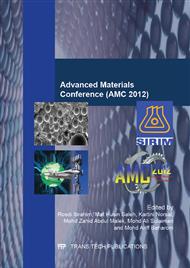p.1
p.7
p.12
p.16
p.21
p.27
p.32
p.38
p.43
Physical, Mechanical and Electrical Properties of W-20 wt.% Cu Composite Produced by Liquid Phase Sintering Process
Abstract:
In this study, the effect of sintering temperature on the properties of tungsten-copper (W-Cu) composite produced by liquid phase sintering (LPS) process has been investigated. W-20 wt.% Cu composite powders with particle size less than 1 μm was prepared by cold compaction and followed by cold isostatic pressing. The green specimens were then sintered under nitrogen based atmosphere in the temperature range of 1100°C to 1300°C. The sintering studies were conducted to determine the extent of densification and corresponding to microstructure changes. In addition, the properties of the sintered specimens such as physical appearance, microstructure evolution, mechanical and electrical properties were presented and discussed.
Info:
Periodical:
Pages:
21-26
Citation:
Online since:
January 2014
Price:
Сopyright:
© 2014 Trans Tech Publications Ltd. All Rights Reserved
Share:
Citation:


